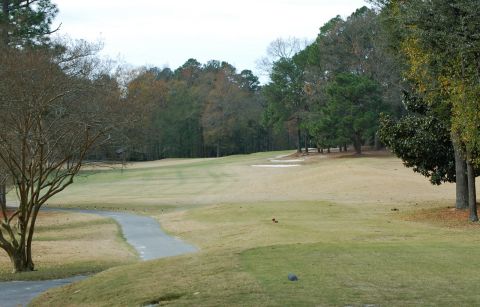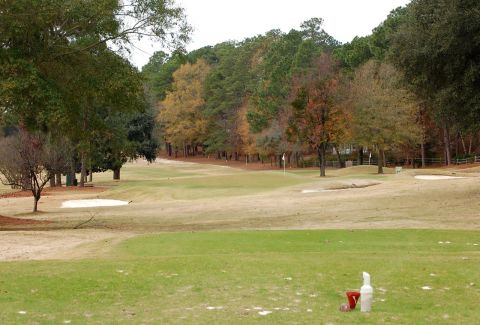Age has taken away my ability to play golf courses from the tips –- until last Monday, when my friend Bob and I teed it up at the classic Donald Ross layout at Camden Country Club in South Carolina. I was at Camden under the sponsorship of the South Carolina Golf Rating Panel, of which I am a member. Bob, who had driven the four hours from his home in Chapel Hill, was my guest for the day.
Camden may not be well known to most of us, or even to many Carolinians, but the town and its club are rich in history. A luxury hotel once sat beside today’s 12th hole, adjacent to what the golf club’s web site describes as a “rather primitive” golf course. In 1922, the hotel’s owners hired the U.S. amateur multiple champion Walter Travis to design a layout that could attract serious golfers to the hotel. But the sand greens that Travis built on the original layout, which were lauded in the early years, fell out of favor as grass science improved. In 1939, the club hired the famed Donald Ross, who decades earlier had designed Pinehurst #2. He rebuilt and grassed the Camden greens and also made significant changes to the entire layout.
At just 6,350 yards at its longest, good drives leave approachable shots to the grass greens at Camden -- ”approachable” being the operative word. The putting surfaces and surrounds are Donald Ross at his best and most diabolical -- nasty, multi-leveled, hard to read and with few flat sections to accommodate pin placements. I counted perhaps two putts all day that did not break at least two or three ball widths. On most golf courses with nasty pin positions, you wonder if the greens superintendent woke up on the wrong side of the bed; at Camden, you look at the greens and wonder where even a generous superintendent could find an easy pin position.


With a sloping fairway (top), strategic bunkers in fairway and at greenside, the 320-yard par 4 5th hole is a classic short hole that does not need any tricks to make it a challenge.
Bob and I thought Camden played sneaky long, and there were times when a well-placed fairway metal off the tee would have yielded an easier approach than a well-struck but only slightly offline driver. Strategic bunkering at greenside and the tilts of the greens put a premium on angles into the greens. In retrospect, I might have given up 20 yards off the tee for clearer sailing on the approach shots. With long irons to well-protected greens, I found myself choosing sometimes to lay the ball up just short of the green rather than risk a shot bounding over the firm greens to impossible positions (most of them from below the green to a slope down toward the front of the green). I know that if I played Camden every day, more of my pars would be of the one-putt variety than from hitting the greens in regulation.
And those greens are so much fun, not in a clown’s mouth kind of way but in a Pinehurst #2 kind of way. Every type of green is on display, except huge ones, the edges of many putting surfaces having pulled away from adjacent bunkers, turning small greens to very small. (Camden’s course was redone in 1999 and is scheduled for another renovation in June, much of the work to be of the restorative variety and to be done by Donald Ross architecture expert Kris Spence.) Although the putting surfaces in December are certainly slower than in June, it is the condition of the turf just off the green that makes par just as elusive in winter. Earlier in the season, the putter would be the club of choice on many shots from 15 yards off the green, but in December, little tufts of grass that resist the lawn mower blades require a little more thought -– and a deftly played wedge to swirling green surfaces.

The par 3 8th hole at Camden is just 140 yards long, but it offers every challenging aspect of a classic one-shotter.
It is too hard to choose the most “memorable” hole at Camden because each one presents different views and different challenges. The par 3s, as a group, are certainly memorable, ranging from short and tricky to long and, well, tricky. The par 3 2nd hole is a mere 167 yards, but no matter the pin position, the double tier may leave a steep uphill putt or, horrors, a slick downhill one. The 6th, the longest of the one-shotters at 225 yards, looks mild enough from the tee box, but a bunker short and right of the green is ready to snare a dying quail and another one just left of the green will trap an overcooked draw. Jamey Bryan, a club member who joined us for the back nine, told me that the 6th plays like a “reverse Redan” in which a shot to the left front of the green –- just inside the bunker -– will bound toward the rear right of the green. The 8th may be the shortest of them all at 140 yards, but bunkers right and left and a green that seems to tilt in numerous directions will make par a long shot. The pin position on the 176-yard 12th was on the crest of a hill at right rear, making a play short of the pin about the only fairly certain two-putt par. And, finally, the 186-yard 16th demands a play toward the left half of the green if the pin is on the right to keep a slightly offline shot from sliding toward the bunker at the right edge. Of course, a bunker at left front makes a high shot mandatory. The 16th is one of the many holes at Camden that cause you to consider the front fringe as, perhaps, the most judicious target.

A railroad once brought guests to a hotel located where condos now stand (background) beyond the 11th green at Camden Country Club. The hotel closed just after World War II.
Camden is a golf course any serious golfer would be happy to play a few times a week, 52 weeks a year, and it can hold its own with any layout in golf rich South Carolina. It is hard to conjure a golf course that is more challenging inside 6,400 yards. If Camden was  sited just outside a major urban area, you might expect a waiting list years long, high hurdles to qualify for membership and an initiation fee high into the five figures (at least). But Camden is in rural South Carolina, 45 minutes from the smallish capital of South Carolina, Columbia, and it is priced to match: An initiation fee of just $1,500 and annual dues around $200 per month. (Note: Those who would like a vote in golf club matters must purchase a “stock certificate” for $5,850, a fair share of a great golf course.)
sited just outside a major urban area, you might expect a waiting list years long, high hurdles to qualify for membership and an initiation fee high into the five figures (at least). But Camden is in rural South Carolina, 45 minutes from the smallish capital of South Carolina, Columbia, and it is priced to match: An initiation fee of just $1,500 and annual dues around $200 per month. (Note: Those who would like a vote in golf club matters must purchase a “stock certificate” for $5,850, a fair share of a great golf course.)
Those who live outside the area and worship at the altar of Donald Ross will find Camden the ultimate bargain, with a non-resident membership at just $500, with dues of $1,835. Play 50 times during the year and the per-round cost works out to well under $40. I daresay serious golfers would pay four or five times that for a go at Ross’ greens. In case that is tempting to you, homes in Camden are priced as you might expect for a rural area. You won’t find too many along the perimeter of the course, although a large and beautiful colonial that does overlook the course is currently on the market for just $200,000; a local realtor told me it needs about $150,000 worth of renovations. A few condos behind the 12th hole, when available, are priced well under $200,000.
Interested? I have made the acquaintance of a local realtor who would be pleased to share information about the local market. Contact me and I will put you in touch.



